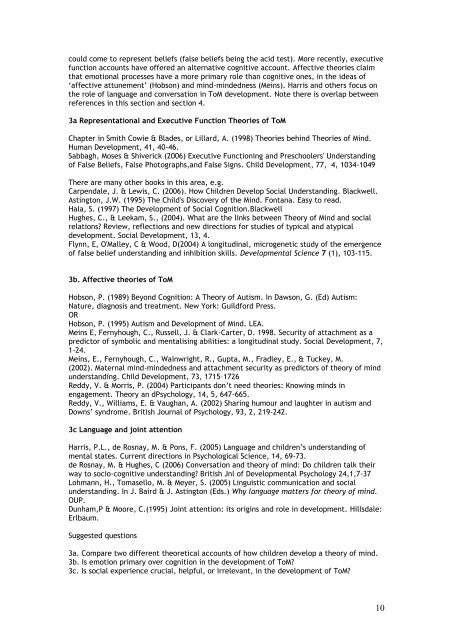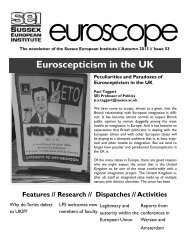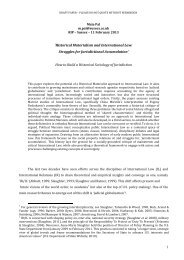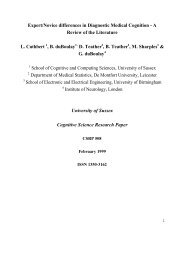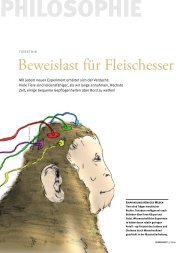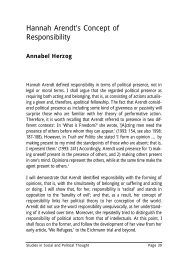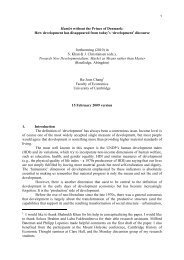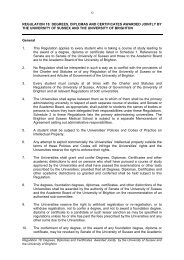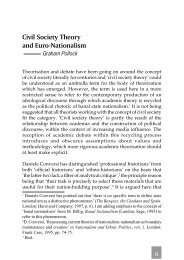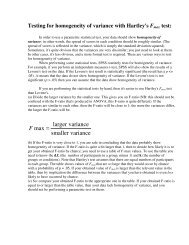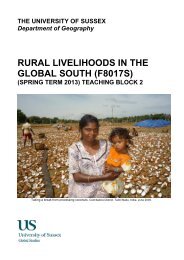Social Cognitive Development handbook 13-14 - University of Sussex
Social Cognitive Development handbook 13-14 - University of Sussex
Social Cognitive Development handbook 13-14 - University of Sussex
Create successful ePaper yourself
Turn your PDF publications into a flip-book with our unique Google optimized e-Paper software.
could come to represent beliefs (false beliefs being the acid test). More recently, executive<br />
function accounts have <strong>of</strong>fered an alternative cognitive account. Affective theories claim<br />
that emotional processes have a more primary role than cognitive ones, in the ideas <strong>of</strong><br />
‘affective attunement’ (Hobson) and mind-mindedness (Meins). Harris and others focus on<br />
the role <strong>of</strong> language and conversation in ToM development. Note there is overlap between<br />
references in this section and section 4.<br />
3a Representational and Executive Function Theories <strong>of</strong> ToM<br />
Chapter in Smith Cowie & Blades, or Lillard, A. (1998) Theories behind Theories <strong>of</strong> Mind.<br />
Human <strong>Development</strong>, 41, 40-46.<br />
Sabbagh, Moses & Shiverick (2006) Executive Functioning and Preschoolers' Understanding<br />
<strong>of</strong> False Beliefs, False Photographs,and False Signs. Child <strong>Development</strong>, 77, 4, 1034-1049<br />
There are many other books in this area, e.g.<br />
Carpendale, J. & Lewis, C. (2006). How Children Develop <strong>Social</strong> Understanding. Blackwell.<br />
Astington, J.W. (1995) The Child's Discovery <strong>of</strong> the Mind. Fontana. Easy to read.<br />
Hala, S. (1997) The <strong>Development</strong> <strong>of</strong> <strong>Social</strong> Cognition.Blackwell<br />
Hughes, C., & Leekam, S., (2004). What are the links between Theory <strong>of</strong> Mind and social<br />
relations? Review, reflections and new directions for studies <strong>of</strong> typical and atypical<br />
development. <strong>Social</strong> <strong>Development</strong>, <strong>13</strong>, 4.<br />
Flynn, E, O'Malley, C & Wood, D(2004) A longitudinal, microgenetic study <strong>of</strong> the emergence<br />
<strong>of</strong> false belief understanding and inhibition skills. <strong>Development</strong>al Science 7 (1), 103-115.<br />
3b. Affective theories <strong>of</strong> ToM<br />
Hobson, P. (1989) Beyond Cognition: A Theory <strong>of</strong> Autism. In Dawson, G. (Ed) Autism:<br />
Nature, diagnosis and treatment. New York: Guildford Press.<br />
OR<br />
Hobson, P. (1995) Autism and <strong>Development</strong> <strong>of</strong> Mind. LEA.<br />
Meins E, Fernyhough, C., Russell, J. & Clark-Carter, D. 1998. Security <strong>of</strong> attachment as a<br />
predictor <strong>of</strong> symbolic and mentalising abilities: a longitudinal study. <strong>Social</strong> <strong>Development</strong>, 7,<br />
1-24.<br />
Meins, E., Fernyhough, C., Wainwright, R., Gupta, M., Fradley, E., & Tuckey, M.<br />
(2002). Maternal mind-mindedness and attachment security as predictors <strong>of</strong> theory <strong>of</strong> mind<br />
understanding. Child <strong>Development</strong>, 73, 1715–1726<br />
Reddy, V. & Morris, P. (2004) Participants don’t need theories: Knowing minds in<br />
engagement. Theory an dPsychology, <strong>14</strong>, 5, 647-665.<br />
Reddy, V., Williams, E. & Vaughan, A. (2002) Sharing humour and laughter in autism and<br />
Downs’ syndrome. British Journal <strong>of</strong> Psychology, 93, 2, 219-242.<br />
3c Language and joint attention<br />
Harris, P.L., de Rosnay, M. & Pons, F. (2005) Language and children’s understanding <strong>of</strong><br />
mental states. Current directions in Psychological Science, <strong>14</strong>, 69-73.<br />
de Rosnay, M. & Hughes, C (2006) Conversation and theory <strong>of</strong> mind: Do children talk their<br />
way to socio-cognitive understanding? British Jnl <strong>of</strong> <strong>Development</strong>al Psychology 24,1,7-37<br />
Lohmann, H., Tomasello, M. & Meyer, S. (2005) Linguistic communication and social<br />
understanding. In J. Baird & J. Astington (Eds.) Why language matters for theory <strong>of</strong> mind.<br />
OUP.<br />
Dunham,P & Moore, C.(1995) Joint attention: its origins and role in development. Hillsdale:<br />
Erlbaum.<br />
Suggested questions<br />
3a. Compare two different theoretical accounts <strong>of</strong> how children develop a theory <strong>of</strong> mind.<br />
3b. Is emotion primary over cognition in the development <strong>of</strong> ToM?<br />
3c. Is social experience crucial, helpful, or irrelevant, in the development <strong>of</strong> ToM?<br />
10


